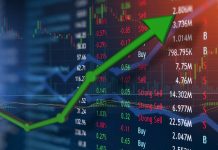This article is not a recommendation and is intended for educational purposes only.
Yesterday was a roller coaster for the market, but it could suggest volatility will ease.
S&P 500 futures (@ES) began the session down more than 30 points after China retaliated against U.S. tariffs. Everyone freaked out… pretty much par for course over the last few weeks. But then something funny happened: @ES held its ground and started clawing its way back. By the time the closing bell rang, it was more than 30 points above Tuesday’s close.
There were no immediate reasons for the rally. Sure ADP’s jobs report beat estimates, but that wasn’t much different than the trend of strong hiring we’ve seen for months. It seems more like people are tired of being scared. After all, how long can anyone stay negative when the economy is this good… especially with earnings season around the corner?

Technicals also stand out because Wednesday’s big swing included both a higher high and a lower low than the previous session. That kind of “outside day” is often viewed as a reversal pattern that marks a potential change in direction. And, considering how the recent direction has been down, a reversal in this case would be potentially bullish. On top of that, a quick analysis on RadarScreen® shows that 212 of the S&P 500’s member companies had outside days.
But there’s more, because not all outside days are created equal. They were actually pretty common last year when @ES was lucky to move 20 points in a single session. Yesterday’s 90-point whipsaw from high to low was the biggest high-to-low range for an outside day since November 9, 2016, the day after Donald Trump was elected U.S. President.
There are two other chart patterns to watch. First, @ES bounced at its 200-day moving average — a key long-term trend signal. Second, the index managed to hold the same 2600 zone where it peaked in November and bottomed in February. Take those technical factors, throw in Friday’s non-farms payrolls report and the onset of earnings next week, and we could finally be near an end to the recent swoons in volatility.























